Sustainability is generally understood and accepted as an environmental and ecological concept. From a more holistic lens, sustainability means an equal balance of environmental, economic, and social equity. The Future of Now: Contemporary Art in Our Unsustainable World is a Colorado art exhibition hosted on Auraria Campus to increase public awareness of holistic sustainability while highlighting the least represented aspect, social. Starting with a small group of female artists and designers on Auraria Campus, this cross-disciplinary exhibition extended to all Coloradans in an effort to expand and diversify participants. Artists had to answer the question, "what does sustainability look like to you?" with the option of representing one or more of the three aspects of holistic sustainability.
The Future of Now: Contemporary Art in Our Unsustainable World observes and challenges the intersection of current trends in American culture and sustainable action. This exhibition invited Colorado artists to explore the meaning of sustainability in visual representation. While sustainable efforts are widely understood as an environmental and ecological concept, the exhibition’s concept is an assertion that art is vital in encouraging attitudes to shift toward a holistic perspective for long-term economic, environmental, and equitable growth. Seventeen Colorado artists interpreted the Call for Entry through a combination of lenses in economic, environmental, and social sectors. Emotion and calls for action are communicated in their cross-disciplinary and aesthetically varied body of works. Taken together, the artists and work in this exhibition demonstrate how humans are influenced over time, as well as our ability to positively contribute to that influence.

Michelle Franco // Global Masquerade full installation

Franco // Perspective stepping up to a mask

Franco // User perspective through a mask
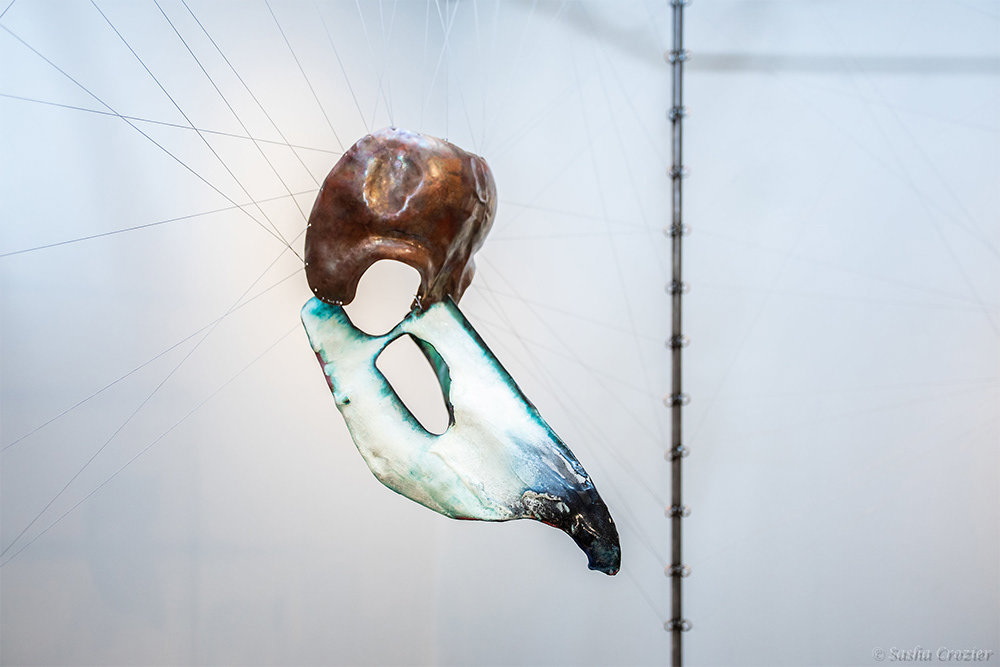
Killing Me Softly, 2019

Killing Me Softly, 2019

Killing Me Softly, 2019

Earth Does Not Belong to Man, Man Belongs to the Earth, 2018 // User perspective view

Earth Does Not Belong to Man, Man Belongs to the Earth, 2018

Carbon Emitted, 2019
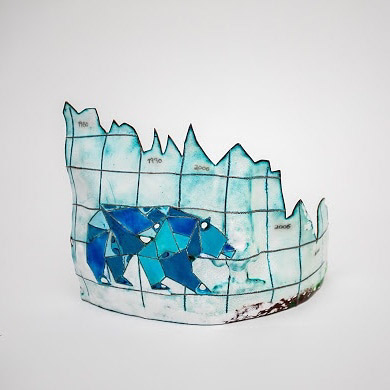
Carbon Emitted, 2019

Carbon Emitted, 2019 // side view

Carol Bleaching, 2019

Save Your Breath, 2018

Save Your Breath, 2018

Hurricane Future, 2019 // User perspective view

Hurricane Future, 2019 // Front and back
Global Masquerade
2019
Michelle Franco
Reclaimed Steel, Enamel, Graphite, Copper, Found Objects
Global Masquerade invites people to interact with suspended masks while learning about climate change. Each mask allows the viewer to confront their participation in the global warming problems, while at the same time presenting a solution. This work targets humanity’s need to make changes to benefit the planet. Each mask inhabits an interactive environmental issue while juxtaposing the idea of hiding behind a mask to avoid issues.
Masks can be overwhelmingly beautiful, like those meant for a masquerade, but they ultimately exist to hide behind. Many politicians wear a metaphorical mask, shying away from problems they do not want to address.
Six masks are linked together in a webbed string formation, which unites in an octagon arrangement. The viewer sees their reflection by looking through the mask into a mirror that stands within the octagon center. Each mask represents a different ecological concern that is part of a larger obstacle. The arrangement allows the viewer to select which problem to address. When interacting with the masks of Global Masquerade, one peers through and sees themselves in the mirror beyond. This interaction creates an awareness of many environmental issues while granting participants an opportunity to discover methods in which they can contribute towards the goal of reducing climate change.
Robert MacArthur studied repeating patterns in organic shapes, plants and animal life in his theory of Patterns, Models and Predictions. Current patterns in climate change affect plants and animals negatively; it is imperative that this cycle be broken.
The strings that hold the masks appear randomly placed, however, there is a direct correctly to Gilles Deleuze and Felix Guattari’s theory of rhizomes, specifically cartography and decalcomania as describes in A Thousand Plateaus. Deleuze and Guattari employ rhizomes as a metaphor for social structures; they proposed that a rhizome is map like and heterogeneity explains how any point can be connected no matter how similar or different. They opposed hierarchical systems opting from more horizontal transitions. The strings as well as the octagon formation within this installation mimic their theoretical position in that an entrance to make a difference exists at any point as well as climate change issues are inherently linked.
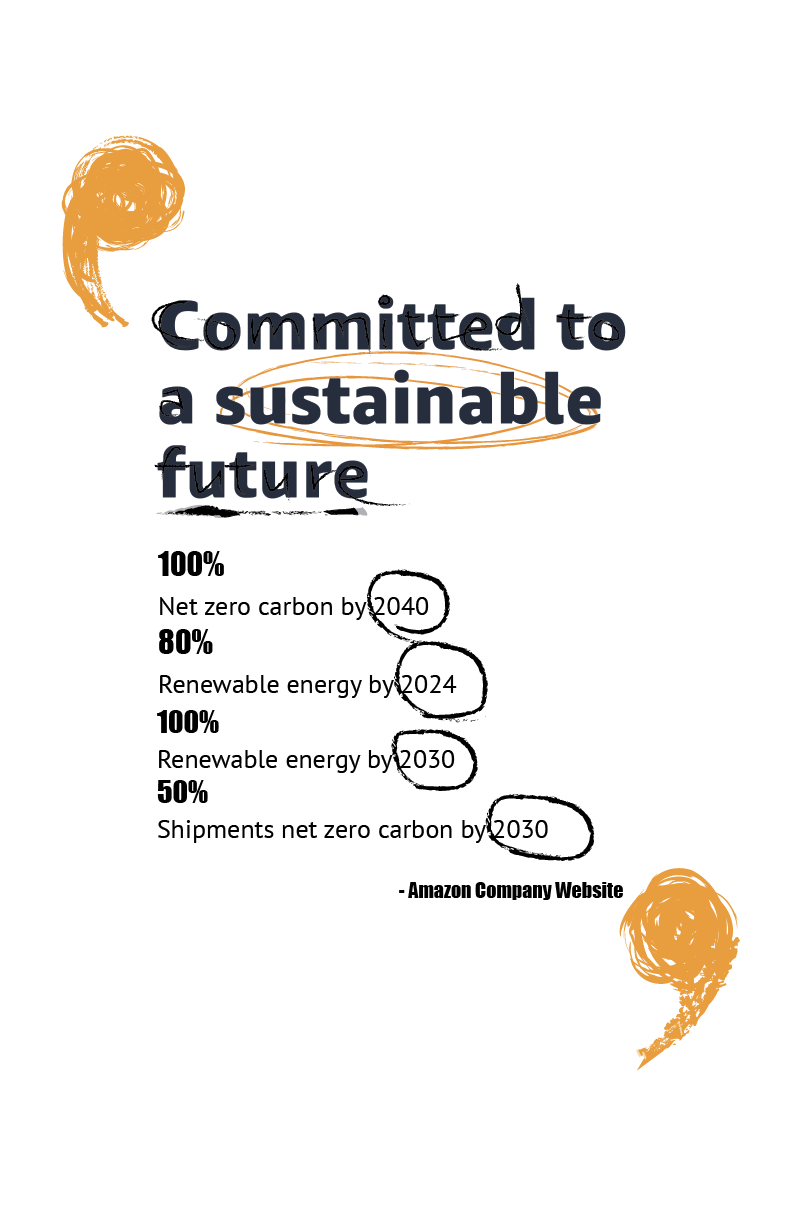
Ontiveros // Artboard 1 // Amazon’s Commitment to a Sustainable Future

Ontiveros // Artboard 2 // Present Impact / Change

Ontiveros // Artboard 3 // Question for thought

Ontiveros // Artboard 4 // CEO: Jeff Bezos
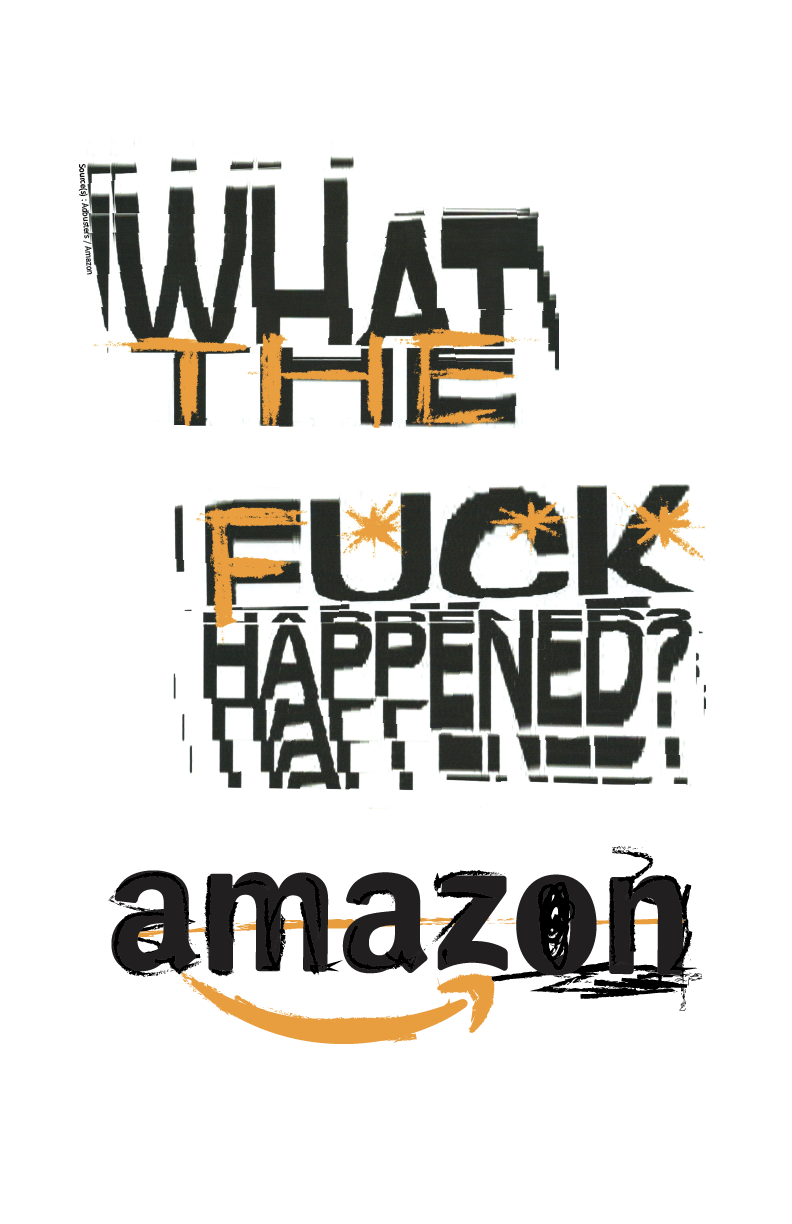
Ontiveros // Artboard 5 // Title – ‘What The Fuck Happened Amazon’

Ontiveros // Artboard 6 // Amazon’s Claims for Social Responsibility

Ontiveros // Artboard 7 // What is needed? - Call to Action

Ontiveros // Artboard 8 // Impacts on World / The Economy

Ontiveros // Artboard 9 // CALL TO ACTION / RECOMMENDATIONS
What the Fuck Happened Amazon?
2020
Ash Ontiveros
Digital Designs With Content From Adbusters
Sustainability to me, means addressing leading companies / corporations for lean and green operations, and ensuring that they are promoting these practices rather than stating them. To see a sustainable future, leading companies must be able to provide a direct path towards a healthy ecosystem. If they are unable, giving recommendations, or finding ways to bring awareness to their un-sustainable practices is a start in the right direction.
This art piece consists of nine artboards that call-out the company ‘Amazon’ for its un-sustainable practices, address the company actions already made, including the changes needed, as well as provide a call-to-action. The goal is to not only have a sustainable future, but to have a sustainable present.
That is what is growing in importance today. The fact that the world is suffering NOW and cannot wait years and years to see the change it needs TODAY! The importance of this art piece is to showcase that Amazon is one of the most leading impactful e-commerce industries in the world. It affects the lives of many in terms of online purchases, industry work, and economic flux.
Amazon makes claims to promote a sustainable future but is doing nothing but reveling in current profits and success. Their commitment to green energy did not meet their expected value of ‘~40% renewable energy by the end of 2019’. They in-fact sit somewhere around 12% in the Spring of 2020. *
It was also important to call out Amazon’s commitments to social responsibility and address the fact that they are not following company policy and are undercutting workers’ rights and worker safety. These are social impacts that are not acceptable for the LEADING WORLDWIDE COMPANY. The richest man in the world should not continue to get mass consumer money if the ethical practices of his business are detrimental to the economy.
Mixed Feelings
Signer: Gabbie Secker from Hey There Rabbit
Motion Graphics Animation: Emily Weinceck
Gabbie, songwriter, and artist of Hey There Rabbit, wrote the song Mixed Feelings. She went on a trip to Bryce Canyon National Park, where she got inspired to write Mixed Feelings. Incredibly relatable to people who have random negative thoughts due to depression. Her goal of the song is to speak upon the quality of life. As humans, we experience negative thought patterns at least once in our life. The two of us have been working together to create an audiovisual narrative for her song. Bryce Canyon was a huge influence, and the feelings she experienced during the trip will be portrayed in an abstract form in the animation. Singer and songwriter Gabbie Secker wants to capture feelings of morbidity and insecurity by using examples specific to my life. My aim is to break down the unsustainable attitude society has towards mental health through acute vulnerability."




Alloy Typical; Innate Forms of Discontinuity
2019
Chelsea Minter-Brindley
Bronze Sculptures
Alluding to Umberto Boccioni's Unique Forms of Continuity in Space, and his call to disrupt classical ideologies within art.
I notice the invisible nature of textile labor within Western culture: the ability of fiber materials to exist fluidly between aesthetics and practicality, as well as the inherent sculptural qualities within garment making. When I was a child, my mother, who worked at a sewing factory, would hand-sew clothing from scrap pieces for my dolls. When she brought these outfits to me during a visit in late 2019, I became interested in the invisible and allegedly "natural" (women's) labor associated with this craft, as well as the memories surrounding their creation. Alloy Typical was produced as a collaboration between mother and daughter, a link between artists of different generations. I solidify the invisible and equate and the lost-wax casting process with "lost" textiles and lost childhood, the intangible past, my past, also my current self. Considering issues surrounding women and gender in art, I wanted to use bronze casting as a transformational method/medium, understanding that the original garments would be destroyed in the process as an attempt make visible painstaking labor, while also disrupting the "continuity" of their original associations with a supposedly-essential "women's work."
We are working with unsustainable social infrastructure. For me, sustainability encompasses not only caring for the planet but also reexamining our current socioeconomic hierarchy and asking ourselves whether or not our existing political, social, and exploitive labor structures are sustainable. Evermore pertinent within our current pandemic, we can see that these structures, as they crumble, were never viable in any capacity. It is time to question the sustainability of our cultural practices as we are all forced to reposition our thoughts and reexamine what is precious and valuable.

Grace Hoag // Full Artwork

Hoag // Detail 1
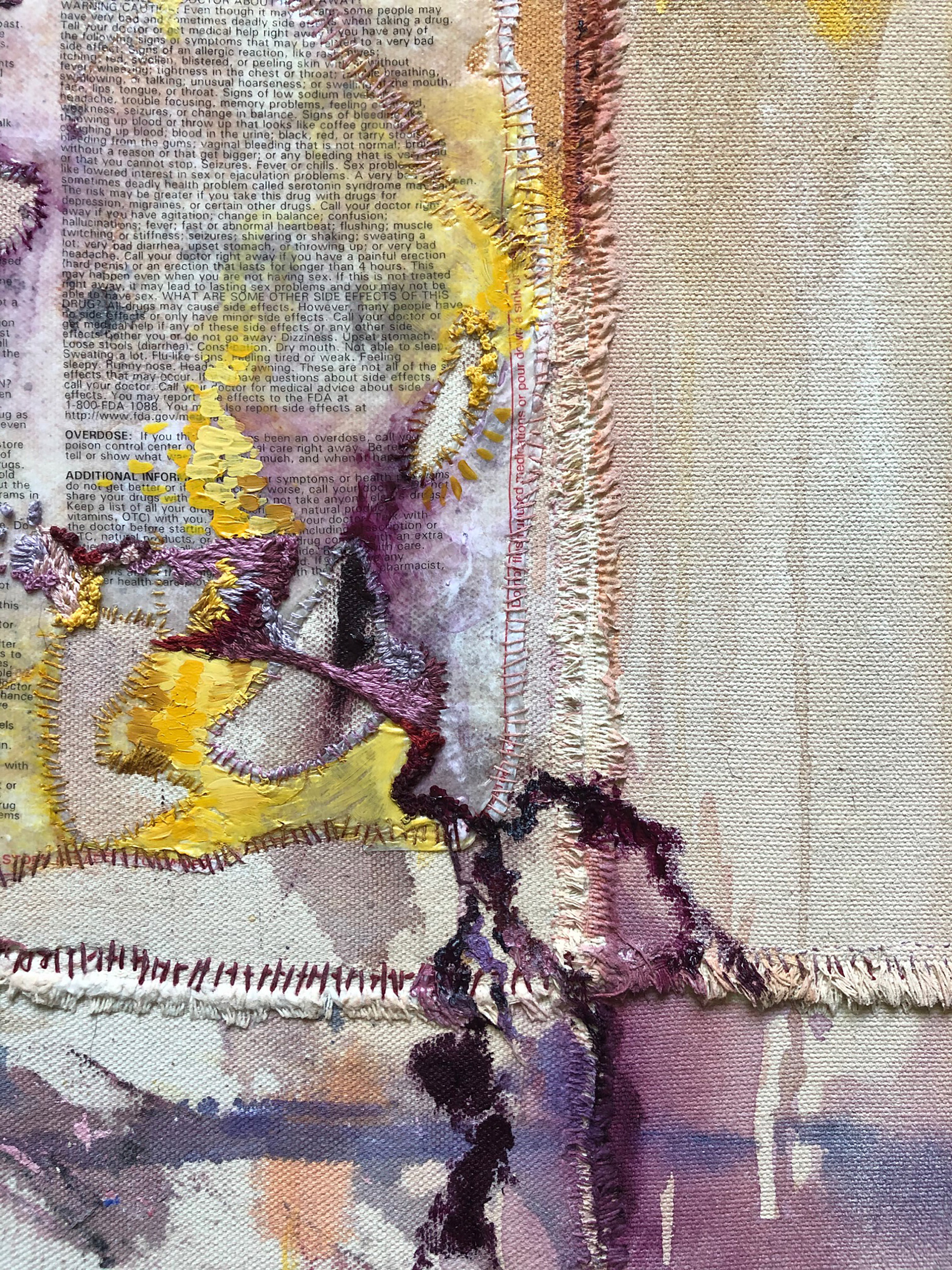
Hoag // Detail 2
Personal Prescription
Grace Hoag
Acrylic, Image Transfer, and Cotton on Canvas
Personal Prescription is a mixed-media painting exploring the relationships between intense emotions, mental illness, and sustainable art practices. This painting utilizes text transfers of pharmacy ephemera, papers that are quickly useless and intended to be thrown away, and interrupts this process of single-use information by immortalizing the information on scraps of canvas. The personal prescription is for Escitalopram which is a medication used to treat generalized anxiety disorder and depression; I took this medication for a period of time before finding it ineffective for my needs. Mental healthcare is inextricable part of social sustainability, and the mental healthcare system currently available is lacking. Medication, diagnosis, and counseling are difficult to attain but necessary to support a healthy society. This painting, like therapy, is a patchwork of different materials, sources, and techniques: exploring the complex nature of art, illness, and sustainability.

Denise Zubizarreta // Olagarro

Zubizarreta // Olagarro
Olagarro
Denise Zubizarreta
Steel, Copper & Aluminum Wire on Wood Base
We are more connected today than ever before yet we find ourselves further apart. We’ve forgotten our innate human connection, the true ties that bind and interweave between us all. Without each others support how do we showcase viable communities to future generations?
Amidst frightening political, economical and environmental changes; it is time to peel back the outside layers that cloak us from our interconnected reality. The spiral and weave of our humanity, standing on its own, demanding a reminder of the armature that stabilizes us all- one another.
Anti-State
2020
Emily Przekwas
Digital Photobook
Donald Trump promised law and order but he delivered lawlessness and chaos. His failed philosophy and inept leadership was on full display across the country this summer. The political protests instigated by the murder of George Floyd at the hands of police illustrate the tenous foundation of hierarchy, dominance, and submission that informs contemporary society. It revealed our concept of democracy and consent is superficial at best and bolstered by repressive elements antithetical to freedom, expression and safety. Ultimately, investing in sadomasochism as a security force is unsustainable and untenable. We must deviate and evolve to prevent another civil war, world war, or worse nuclear holocaust. The recipe for revolution is one that has been used by activists throughout history. This work illustrates some of the ingredients present in this summer's protests. The protests were a caustic mix of anarchism and contempt for hierarchy, racial justice in the form of Black Lives Matter, iconoclastic destruction of sacred symbols and icons, Marxist organizing and hindered by the ever present surveillance state. Success will be determined by how eloquently and effectively we can utilize these forces in concert.
23 Pairs
Devoe Harris
Silver Gelatin Print
Chromosomes contain DNA, which provides genetic information that makes each living thing unique. A karyotype is an image of an organism’s chromosomes. My dreadlocks resemble the appearance of these thread-like structures, so I cut strands of my hair to suggest a karyotype.
An image of chromosomes is usually created by staining and photographing them through a microscope. Humans have 23 pairs of chromosomes, the 23rd pair being the sex chromosomes, which determine the reproductive anatomy of a newborn. Since birth, our ideas of gender have been constructed based on the genitals, informing how one orients throughout the world.
An image of chromosomes is usually created by staining and photographing them through a microscope. Humans have 23 pairs of chromosomes, the 23rd pair being the sex chromosomes, which determine the reproductive anatomy of a newborn. Since birth, our ideas of gender have been constructed based on the genitals, informing how one orients throughout the world.
I am inspired by pioneers in the history of photography like Man Ray, sometimes considered the father of the photogram. He placed objects on a piece of photographic paper, and then exposing it to light. The shadows of the objects on the surface are what produced the image. I too focus on the key principles of making a photograph—light and shadow.
I am drawn more to the process of experimentation than the final result, so cameraless photography techniques challenge me to approach the darkroom differently than conventional practices. There are infinite ways to transform the surface of the photographic paper. Hair, as one of the most visible ingredients of one’s identity, articulates and informs the public about our own internal feelings. By appropriating the image of a human male karyotype, I create a new dimension to the work by incorporating my own DNA (my hair) to perform as chromosomes.

Elena Nierrman // No Vacancy Series

Niermann // No Vacancy Series

Niermann // No Vacancy Series
No Vacancy Series
Elena Niermann
Photographic Print
The “No Vacancy” series was inspired by my mother, an adamant environmental activist, who reminded me that humans rarely give more than they take, especially when it comes to the use of resources where profit is involved. I began to observe and analyze my surroundings; to notice where humans had left their trace, even deep into the Colorado mountains where I found tourist filled roads and trash covered national park trails. I turned my camera to the exploration of the differences between use and exploitation of uninhabited spaces and natural resources. I want to capture the melancholy of natures struggle to reclaim itself in the empty spaces and leftover debris of human interaction with the environment, and also the ironic beauty of such a struggle, sometimes slow like vines climbing abandoned houses, and sometimes much more sudden like the explosion of an unchecked fracking site. I hope this series influences the viewer to further contemplate how we have an impact on every space we inhabit, and even the ones we don’t.
Green Revolution
Arturo Javier Mireles
1920 x 1080 Film
In America, hemp was suppressed for 81 years until the implementation of the agricultural act of 2018. Upon the premiere year of the regulation of American hemp our crew has captured 15 informative interviews from across the world. The results of our inquiry were not as expected as we learned the practices taken by businesses that exploit an uninformed public, as well as the of practice of using cheap labor to harvest their product. We would have presented our results via documentary at The College of Arts & Media Cinefest for our Senior Thesis. Cinema is the best way to exhibit these result because people can read the page individually, and at the same time, groups of people can experience the same film collectively. Hemp is more than just CBD. It can help save our planet.
Carrots, Paonia, Colorado, 2015
Trent Davis Bailey
Archival Pigment Print
This photograph comes from my series, The North Fork, which takes its form from several threads of my childhood memories — including a rift between my father and an uncle and the premature death of my mother — and suggests how those remembrances tie into small-scale family farms and wilderness in the rural Mountain West. Photography, here, becomes a tool for piecing together a map of my own complicated personal terrain, mending and rerouting notions of place and family.
My first indelible memory of the North Fork was a lunch that my Aunt Chrys prepared for my family and me when I was about seven years old. I looked at the colorful servings of food that she placed on the table, most of which were vegetables grown in her garden. Having only experience grocery aisle food before this, I was so intrigued. There were so many strangely beautiful foods that I had never seen before—purple potatoes, snow peas, yellow and green heirloom tomatoes, and multicolored kimchi in a glass jar. The only things that I recognized were store-bought rice, corn, and tortillas, which seemed only distantly related to the homegrown food on the table. In a related manner, this image, “Carrots, Paonia, Colorado, 2015” brings to mind the magic sustenance of that memory. On the other hand, it is also evidence of one farmer’s solution for growing and providing fresh food for himself and his community during midwinter in the mountains of Colorado.
Environmentalism vs. Capitalism
Elena Niermann
Oil Based Ink Linocut Print on Paper
“Environmentalism vs. Capitalism” is representative of the ultimate duality of our future on this planet. To me, sustainability means the preservation of our most important asset: the environment we endlessly rely on. This work illustrates the pathos environmentalists face when bracing ourselves against the world that is so destructive and so resistant to change. While no one can see the future, we fear the one where greed and injustice are too ingrained in our systems and societies to realize the ecosystem is collapsing around us. But it is not just being environmentally conscious that is the means to true sustainability. We must unroot the deepest of social constructs, we must strive for human rights, for equality and social cohesion. A capitalist society prioritizes economic gain over environmental preservation, over the human right of having access to a healthy and clean planet. This piece is illustrative of the juxtaposition we face with climate change and capitalistic success. As a society we might have to choose.

Ken Trujilo // Fuente Grande

Tujilo // La Petit Prince II
Fuente Grande, and La Petit Prince II
Ken Trujilo
Photographic Prints
Ken Trujillo is a fine art and commercial photographer who specializes in capturing the beautiful and sometimes not so beautiful aspects of people and the world. He is a Colorado native, has two daughters and a love of music, words, and life. His personal story has continued to influence his outlook, his inspiration and ultimately his art. His current work is a journey of transcendence to accept and adapt to change. Events of loss, heartache, and a new beginnings were what spurred the evolution of his fine art, abstract photography.
“There is a beautiful way to shoot even the ugliest of things.” –Hillary Fryer This quote came from a dear friend and set Ken on a journey to find beauty in the everyday of life, the simple, the plain, even the mundane and discarded. His art rep-resents the Japanese aesthetic of wabi sabi, the beauty of imperfection, transience and impermanence. Ken photographs fragments of everyday life that no one notices and exposes their inherent beauty.
His technique involves the uncovering of the colors and detail from the inner depths of the original images in vipaśyanā, Sanskrit in the Buddhist tradition for insight into the true nature of reality. He often uses poetry, quotes or lyrics to convey his inter-pretation of each piece in relationship to life.
Scott's Math, Paonia, Colorado, 2017
Trant Davis Bailey
Archival Pigment Print
This photograph comes from my series, The North Fork, which takes its form from several threads of my childhood memories — including a rift between my father and an uncle and the premature death of my mother — and suggests how those remembrances tie into small-scale family farms and wilderness in the rural Mountain West. Photography, here, becomes a tool for piecing together a map of my own complicated personal terrain, mending and rerouting notions of place and family.This image, “Scott’s Math, Paonia, Colorado, 2017” brings to mind many questions: Who is it that penned these equations, lists, and love notes? Why are they written in ink on a peeling calendar and a panel of wood? How old is this weathered barn and how much longer will it stand? Given the economics imaged here, how possible to make a living on a small-scale farm in the 21st century? And finally, what is it that sustains life in this place, in this state, and in this country?
Sensual Earth
Tatianna DuBose
Digital Painting
My work explores the relationship between what environmental factors and what Earth has to offer. With influences as diverse as quality of life and the consistent rising of pollution, I hoped to have created a piece that highlights these topics in a simple but creative way.
I truly wanted to highlight the tears of the subject and the black pollution that the Earth must endure. Over the years we have consistently hurt our planet where the Earth is forced to consume trash. I wanted the presence of the gunk to be known but not overwhelming, similar to how it feels in real life. As humans we have naturally adapted to pollution filled cities or overwhelming heaps of trash. Like in the piece, it is not overwhelming at first but eventually overwhelms the viewer.
As the viewer becomes overwhelmed in the piece, I wanted the viewer to be able to navigate their eyes in the piece with slight bits of color. So the viewer is left with a visual of the outpost of our world.

Emily Przekwas // EcoLogical

Przekwas // EcoLogical

Przekwas // EcoLogical

Przekwas // EcoLogical detail

Przekwas // Fight The Power
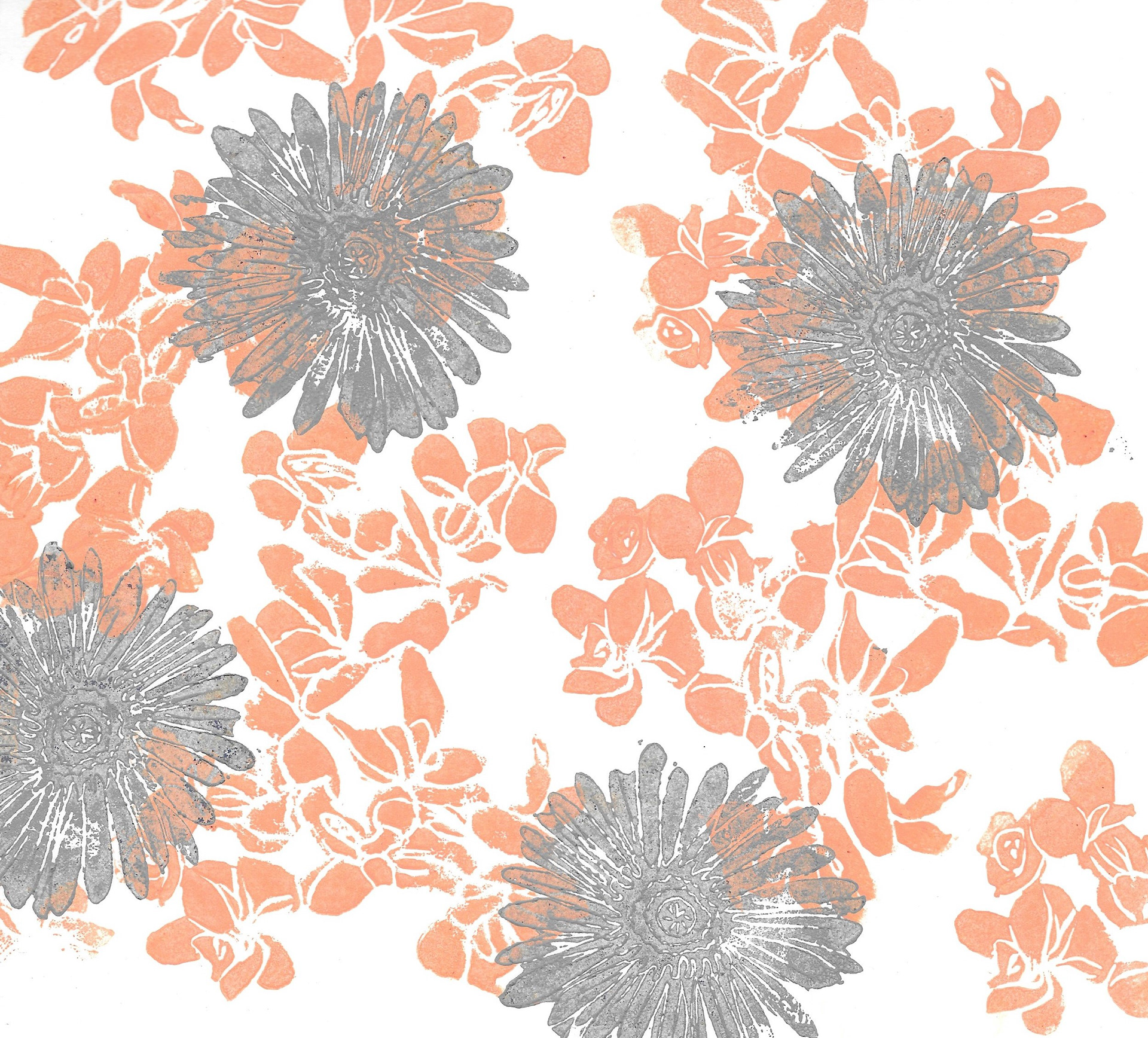
Przekwas // Flower Print

Prezekwas // Flower Print 2
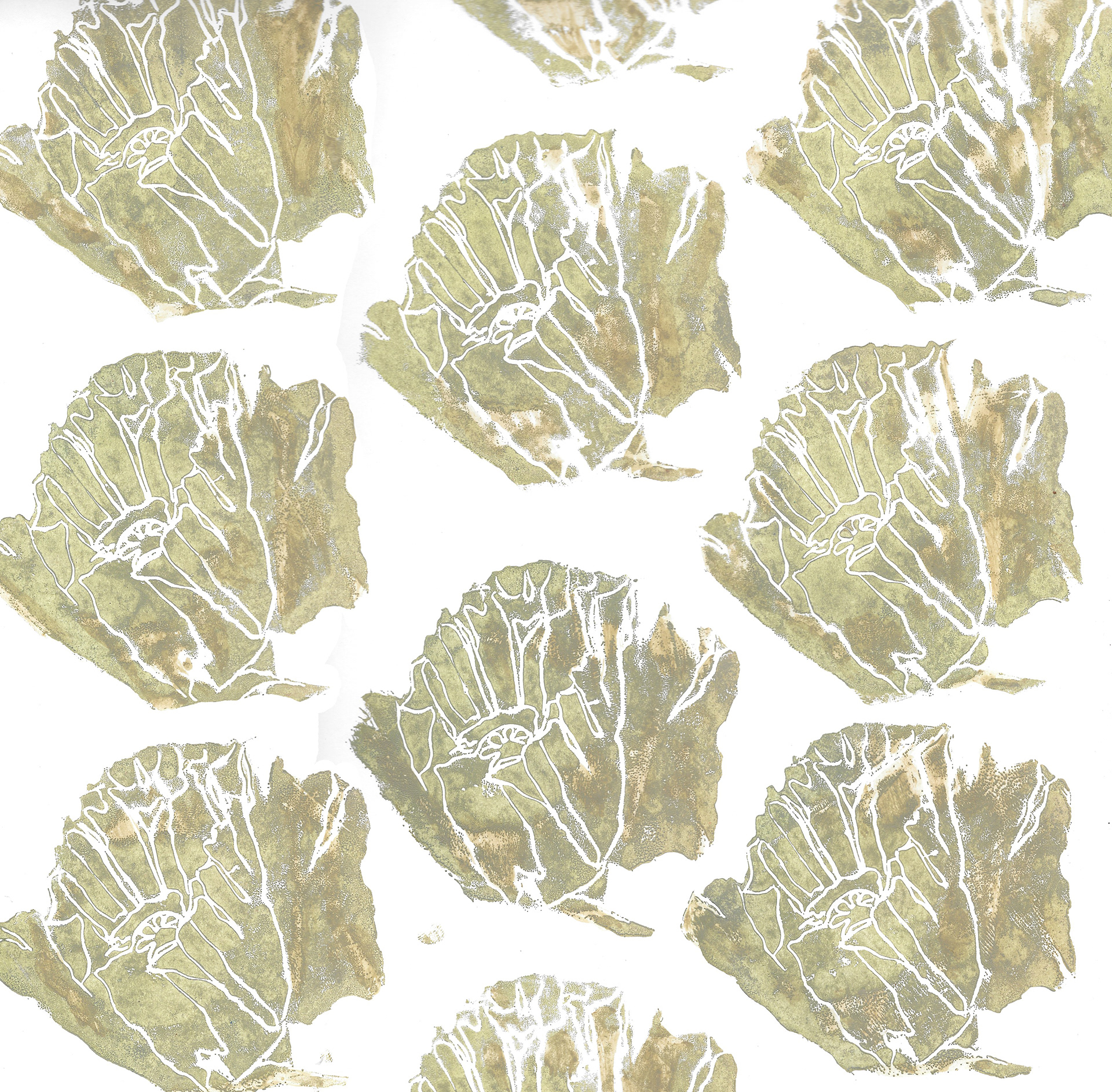
Prezekwas // Poppies Print

Prezekwas // Save The Earth
EcoLogical
Emily Przekwas
Metal, Plastic, Photography Book
Conceptually we enact a barrier between "self" and "environment," but in reality these experiences are intertwined. These logical and psychological constructs and distinctions prevent us from inspecting our surroundings fully and keep things hidden. The result is a psychological cage that traps our thinking and gives rise to problems like climate change, mental health stigmas, addictions, and denial.
In drawing attention to the ecological crisis facing our planet, this project explores the feeling of being trapped, caged, or blocked, and the liberation these boundaries and confines. A couple of years ago I had an intense psychological experience and ended up manically journaling and writing down theories and concepts. When I had this psychological breakthrough I felt like I had passed through a gate of sorts. The drawings in this book are mined from notebooks and papers I kept during that time period.
It was liberating to reveal these chaotic inner thoughts and ideas racing through my mind and put them into the context of nature. There are consequences, because of this link between self and environment, to own our well being when we treat the environment poorly and likewise cultivating a respect for our own existence can translate into a healing force for the environment crisis we face.

Beth Johnston // Discarded

Johnston // Discarded

Johnston // Discarded

Johnston // Discarded

Johnston // Discarded

Johnston // Discarded

Johnston // Discarded
Discarded
Beth Johnston
Photography
The Western landscape of the United States is the central figure in much of my work. I aim to reimagine its depiction and meaning in relation to the changes it has undergone in recent history. What was once a symbol of manifest destiny, untamable wildness, rugged masculinity, and inexhaustible resources for capital gain is today becoming a symbol of overcrowding, extinction, and suburbia.
For Discarded, I gathered common domestic utilitarian objects from thrift stores and systematically placed them into the landscape, photographing them in a deadpan aesthetic. What is first seen as a playful, somewhat absurd scene, gives way to a critique of society’s relationship to nature and consumerism. As we enter the Anthropocene, commodification of land and resources for the comfort of modern life is a very real threat to our future.
As the window to adequately respond to climate change grows smaller and smaller, the need to take action grows exponentially. This action must start with the conversations taking place in living rooms and kitchens, amidst the vacuums, lamps, and toaster ovens.

Haylee Jordan // Heartbreaker logo

Jordan // IBTC Scarf

Jordan // IBTC T-shirt

Jordan // Small Titty Magic T-shirt
Itty Bitty Titty Committee
Haylee Jordan
E-commerce Brand Merchandise
Itty Bitty Titty Goods was created to empower and support women with small boobs, people that have undergone mastectomies, and women that have suffered from breast implant illness. The designs are playful, funny, and even ridiculous at times. Itty Bitty Titty Goods was born from the notion that graphic design should first and foremost create a more sustainable future for women while highlighting seemingly negative body traits in a positive light.



Asking For It (Help)
Emily Przekwas
Metal, Fabric
Habits can be hard to break. A lot of people are in the habit of not asking for help when they need it. It can be hard to ask for help or admit that you have a problem. When it comes to the environment though, we need help. We need help confronting the crisis and we need help to solve it. To me sustainability is about being willing to ask for help when you need it and being able to help others when they are asking for it. This piece takes an image that usually symbolizes pride and victory, a flag, and appropriates it into a symbol of vulnerability. The letters S.O.S. get lost in the floral print of the flag much like our own planet’s “SOS” is inaccessible to some.
Sacred Being
Taylor J Goodman
Oil and Gold Leaf on Canvas
My piece is very symbolic of how the way we view animals relates to sustainability and a healthier Earth. I chose to represent a deer, which is known for being gentle and soft, in a way that makes it seem ethereal and wise. I believe humans should see animals as spiritual and emotional beings. They have just as much of a soul as we do, and are able to communicate and make deep heartfelt connections just like we do. The plants surrounding the deer represent how the earth and environment would flourish when humans start recognizing animals as divine and soulful creatures, as opposed to a commodity they can overproduce and harm. Hurting animals and treating them as objects to sell, produce, and consume, is harmful for the earth in more ways than one. Factory farming accounts for 37% of methane emissions which is considered more harmful than CO2. Illegal poaching and excessive hunting of animals such as deer destroys natural ecosystems which causes a domino effect on other species of animals and plants. Viewing animals in a different light is not the only answer to a sustainable future, but it’s a good start. Let us recognize the intelligence and spirituality in both each other and other beings, and watch the Earth heal together.
The Future of Now: Contemporary Art in Our Unsustainable World partnered with the Auraria Sustainable Campus Program to promote more socially sustainable efforts on the Auraria campus in Downtown Denver.
"Social sustainability is a critical part of our mission. This past year we have focused on food recovery and supporting the food pantries to reduce waste and help those in the Auraria community that are experiencing food insecurity. Now we aim to go back to the drawing board and produce an updated Climate Action Plan that engages and includes more stakeholders from campus that have not participated in the past. We need to hear various perspectives on these pressing issues and engage with those that have not been approached to participate in the past. It is our goal to intentionally reach out to include the vision of any interested student, staff or faculty in the process and have a new Climate Action Plan by June of 2021."
// Chris Herr, MPA | Sustainability Officer
